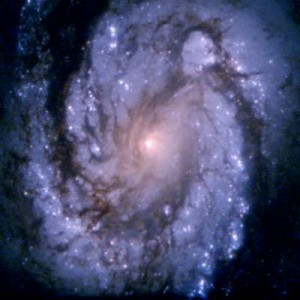Epicurean Physics
 The validity of Epicurean philosophy is grounded squarely on a number of core observations about the nature of the universe. Of these, no principle is more fundamental than the observation that “nothing can be created from nothing.” Epicurus himself would have been the first to insist that if clear evidence existed of things being produced from nothing, then the entire structure of his thought would require massive revision. As Lucretius explains in Book I of De Rerum Natura,
The validity of Epicurean philosophy is grounded squarely on a number of core observations about the nature of the universe. Of these, no principle is more fundamental than the observation that “nothing can be created from nothing.” Epicurus himself would have been the first to insist that if clear evidence existed of things being produced from nothing, then the entire structure of his thought would require massive revision. As Lucretius explains in Book I of De Rerum Natura,
” We shall begin with this first principle: nothing ever comes from nothing by divine power. In truth, fear holds all men in check, because they see many things go on in earth and in the sky, and they fail to understand the cause, believing those things to be done by divine power. Once we shall have seen that nothing can be produced from nothing, we shall then ascertain the explanation of these things, both the elements out of which every thing can be produced and the manner in which all things are done — without the hand of the gods.”
It appears that Epicurus taught that twelve particular principles of physics were of greatest importance. This list, as derived by Norman DeWitt and explained in Chapter 9 of his book “Epicurus and His Philosophy,” was:
-
Matter is uncreatable.
-
Matter is indestructible.
-
The universe consists of solid bodies and void.
-
Solid bodies are either compounds or simple.
-
The multitude of atoms is infinite.
-
The void is infinite in extent.
-
The atoms are always in motion.
-
The speed of atomic motion is uniform.
-
Motion is linear in space, vibratory in compounds.
-
Atoms are capable of swerving slightly at any point in space or time.
-
Atoms are characterized by three qualities, weight, shape and size.
-
The number of the different shapes is not infinite, merely innumerable.
Before discussing these in greater detail, it is important to fall back and recall that Epicurus had a very strict “canon of truth” by which he tested all matters under consideration before holding them to be true. The above list of twelve principles passed this test, but Epicurus emphasized that on many other matters of science judgment must be suspended where clear and uncontradicted evidence cannot be obtained. These matters of science included – in the time of Epicurus – issues such as the size of the sun and matters of astronomy for which evidence was so distant and so difficult to obtain that it was necessary to suspend judgment — to “wait” — until better evidence could be acquired. In the meantime, the intelligent person would entertain as possible any theories which had some evidence to support them, and which did not conflict with any known evidence. But — and this was critically important — but the reasonable person would NOT take a dogmatic position on which of them must be true, as to take a dogmatic position where evidence is unclear is the manner of a priest or an astrologer who seeks power over other men, not the path of intelligent men of good will.
Within the category where waiting was necessary in Epicurus’ time was the famous example his view that the size of the sun was likely not much larger than it appeared in the sky. Even today, it is very helpful to observe how Epicurus reached this erroneous view, which he explicitly noted was NOT a certainty.
Epicurus observed that here on Earth objects that are very far away tend to become hazy and indistinct the greater the distance involved, and he also observed that the size of bright objects such as fire did not tend to diminish in size to the eye as do other objects over great distances. The science of optics or the knowledge of light traveling through space had not yet advanced sufficiently to provide familiar explanations why those phenomena might be produce deceptive results, so when Epicurus observed that the outline of the Sun was sharp in the sky, he was faced with a choice: (1) Accept the theories of the Platonic mathematicians who calculated the size of the sun to be huge, and who combined this belief with the idea that the sun and other stars were gods which rule over men, or (2) admit that the evidence was conflicting, classify the matter as one that was uncertain, and accept the alternative that was consistent with the familiar senses on which all matters of life and death are grounded. Faced with such a choice it is not hard to see why Epicurus tended toward rejecting the opinion of the Platonists.
Had Epicurus lived to see the day when optics, astronomy, and space flight made the true answer obvious, he would have certainly embraced the new evidence and incorporated it into his philosophical writings. The important question for us today is whether the size of the sun, or any other new science developed since the time of Epicurus, invalidates any fundamental principle of Epicureanism. In other words, does the latest science contradict, or reinforce, the view of Nature on which Epicurean ethics must stand or fall?
It should not be surprising that the NewEpicurean blog will take the position that modern science reinforces, and does not contradict, the basic conclusions of Epicurus. Certainly a number of specific scientific statements, of not several of the Twelve Fundamental Principles themselves, will require updating, but perhaps not as extensively as might be expected. I am neither a professional philosopher nor a professional physicist, so I cannot hope to answer that question with the level of detail it requires. Instead, I will use this blog to collect information and links that might be useful to those who wish to carry the inquiry further.
In the meantime, I am simply introducing the topic, and as a small start I am providing a link to a book that I think approaches the subject as should anyone who is devoted to applying Epicurus’ Principle Doctrines and his Canon of Truth:
The book is entitled The Theory of Elementary Waves, by physicist Lewis Little. A recent web page devoted to his theory is also available here. Although I am not qualified to endorse Little’s conclusions, I do endorse his approach. Here is an excerpt from one of the reviews on Amazon.com to illustrate the reasons why physicists who approach quantum mechanics as does Little are important:
For a century, experiments with subatomic particles–such as the double-slit experiment linked to the particle-wave theory of light–have yielded puzzling results. Physicists have long possessed equations that successfully predict these results, but quantum mechanics, the theory that has accompanied those equations, is less satisfying. Like the math, it does explain the results, but only if the physicist accepts such propositions as these:
-A single particle at once occupies multiple, separate locations.
-A particle travels on multiple paths toward multiple destinations but arrives at only one destination.
-The destination of a particle depends on its conscious observer. (Consciousness determines reality.)
-Conscious observation of a particle collapses it from a “superposition of multiple states” into a single state.
-At any given instant, a particle can have only an exact position or an exact velocity, not both.
-Objects can interact from a distance without any physical means to do so.
-Objects can change location instantly (moving at infinite speed).
-Causation can run backward in time (so that an event in the present determines what happened in the past).
Unlike the author, Dr. Little–and unlike Albert Einstein before him–most physicists accepted such propositions. They had no choice: that no other theory had been proposed proved that quantum mechanics was the correct theory, and the illogical nature of this theory proved that the rules of logic were delusions. Many of the physicists who reached this conclusion no doubt had I.Q.s over 200, like Dr. Little’s. These physicists did not, however, match Dr. Little in intellectual discipline or persistence.
As a disciplined thinker, Dr. Little knew that quantum mechanics had to be wrong. As a persistent investigator, he continued his inquiry until he discovered a likely source of the error. Earlier physicists had labored under an unrecognized assumption: that the wave on which a particle of light travels runs in the same direction as the particle. Dr. Little recognized this assumption as an assumption and tried working with the opposite notion: that the wave runs from the particle’s destination to the particle’s source. This alternative notion makes sense of the experimental results that, under quantum mechanics, are explained only by simultaneous occupation of separate locations, interaction from a distance and by no physical means, backward-in-time causation, and so forth.
I also think the researcher into this subject will appreciate the ideas and approach of Robert Prechter, who wrote the introduction to Little’s book, and arranged for its publication. Unfortunately, I cannot find any part of that introduction to include or link to here.
I cannot take sides on whether Dr. Little’s theory is correct or not, but I do suggest that Epicurus warns us to “wait” before we accept theorems based on mathematic constructs that contradict the knowledge of reality which is grounded in our senses.
There’s no better place to close this post than with the words of Lucretius from Book IV of De Rerum Natura:
And so if you find your reason is unable to explain the cause why things which, seen close at hand, are square, but at distance appear round, it is better, if you are at a loss for a reason, to state an erroneous cause, than to let slip from your grasp on any side those things which are manifestly true, and in so doing ruin the groundwork of belief and wrench up all the foundations on which life and existence rest. For not only would all reason give way, but life itself would at once fall to the ground unless you choose to trust the senses, shunning the precipices and errors of this sort that are to be avoided, and pursuing the opposite. All that host of words drawn out in array against the senses is quite without meaning.
Once more: As in a building, if the rule first applied by the builder is awry, and the square is untrue and swerves from its straight lines, and if there is the slightest hitch in any part of the level, all the construction must be faulty, all must be awry, crooked, sloping, leaning forwards, leaning backwards, without symmetry, so that some parts seem ready to fall, and others do fall, all ruined by the first erroneous measurements. So too, all reasoning of things which is founded on false interpretations of the senses will prove to be distorted and false.

